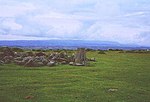Kington Rural
Civil parishes in HerefordshireUse British English from July 2022

Kington Rural is a civil parish in west Herefordshire, England, and is approximately 17 miles (30 km) north-west from the city and county town of Hereford. The parish borders Wales at the west, and contains the hamlets and small settlements of Upper Hergest, Lower Hergest, Chickward, Bredward, and Kingswood at the south, and Bradnor Green and Rushok at the north. The nearest town is the market town of Kington which, with its parish, is to a large extent enclosed by Kington Rural. Significant landmarks of the parish are the Castle Twts motte and bailey earthwork, Hergest Court 15th-century manor house, and Hergest Ridge on the England–Wales border.
Excerpt from the Wikipedia article Kington Rural (License: CC BY-SA 3.0, Authors, Images).Kington Rural
Upper Hergest,
Geographical coordinates (GPS) Address Nearby Places Show on map
Geographical coordinates (GPS)
| Latitude | Longitude |
|---|---|
| N 52.1952 ° | E -3.0713 ° |
Address
Upper Hergest
Upper Hergest
HR5 3EN , Kington Rural
England, United Kingdom
Open on Google Maps




